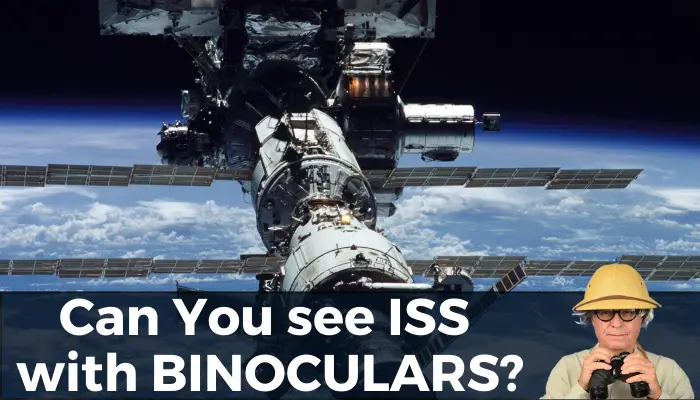This post may contain affiliate links which means I may receive a small commission for purchases made through the links. Learn More
Have you ever looked up at the night sky and noticed a bright moving object that you couldn’t quite identify? If you have ever seen something like that then you have already seen the satellite and ISS (International Space Station). These smaller objects move very fast and it becomes very hard for a normal person like you and me to view them with details.
Many of my friends belong to the astronomy field and their kids just love stars, satellites, and all those stuff that relate to astronomy. For writing this guide, I have done the research and taken the help of my friends.
Those people who have an interest seem to be excited about watching the satellites and ISS. So, if you’re one of them, then you would have thought about using binoculars to see those moving objects. Am I right? Can you see Satellites & ISS (International Space Station) with Binoculars? This is going to be the topic today.
Yes, you can see satellites and the International Space Station (ISS) with high-powered binoculars. The best time to view them is during specific windows that last for 4-5 minutes. It is unlikely that you will be able to see them with the naked eye.
It was just a brief introduction, I have got a goldmine of information and I am sure that you would not like to miss it. So stay connected.
Related Article: Can You Transfer the Warranty of Binoculars?
What are Satellites and ISS?
Satellites are man-made objects that orbit the Earth and are being used for a variety of purposes, such as communication, navigation, and weather prediction. On the other hand, the ISS which is an abbreviation of International Space Station is a place or a kind of habitat for the astronauts and their workers.
The ISS is approximately 250 miles (400 kilometers) away from the surface of the earth which looks like some serious distance. Due to this distance, a normal man cannot see the satellites and ISS. In ISS, many astronauts live and conduct their research process there. It was launched by the collaboration of many space agencies whose names are listed below;
- ESA (Europe)
- CSA (Canada)
- JAXA (Japan)
- Roscosmos (Russia)
- NASA (United States)
Can You See Satellites with Binoculars?
If you’re asking this question it means that you’ve already tried to see the ISS and failed to get a view of those rapidly moving objects. Am I right? Satellites and the International Space Station are very far from us and the naked eye cannot see them. Even if you’re lucky and get a glimpse, the size of the object will look very small and you won’t be able to see the objects in detail.
But worry not, as you can see those objects by using high-powered binoculars. Modern binoculars come with amazing magnification power which enables you to get a closer view of objects which are very far from you. With the help of any of such high-powered magnification binos, you will be able to see satellites and ISS for a few minutes.
The extent of the details that you’ll be able to see through the binoculars depends on multiple factors. One thing is for sure you can see them but how much detail you will be able to see varies with different factors which are mentioned below;
1- Distance from the Observer
The distance of the satellite from the observer is an important factor in determining its visibility. If the distance between a satellite and the binocular user is less, the chances are high that the user will be able to see more detailed and clear visuals through the barrel of binos and vice versa.
Point to Remember: Satellites that are closer to the observer appear larger and brighter in the sky and you’ll be able to see them without any problem
2- Size of the Satellite
How big is the satellite? This is an important factor that can have an impact on the details of the visuals. Usually, when you look at objects (satellites) that are bigger in size look more prominent. You see them with comfort without giving any special effort.
Helpful Point: Satellites are smaller in size, reflect less sunlight, and appear dim and you failed to get full details of them.
3- Reflectivity of the Satellite’s Surface
How much sunlight a satellite reflects the light also counts when you see them through the binoculars. Those objects which reflect more sunlight are easy to see. In contrast, satellites that reflect less light look less bright and the users find it tough to get complete details.
Additional Knowledge: The phenomenon of reflectivity of the satellite’s surface is called albedo. In other words, it is actually a measurement of how much light is reflected by the satellite.
All the factors that have been discussed above play a vital role. It won’t be wrong to say that if all these factors are against you, then chances are high that you’ll have very compromised visuals of satellites and the ISS.
How to find and Track Satellites and the ISS?
Did you know that the International Space Station (ISS) and all other objects in orbit are constantly moving? To see them, you have to be at the right location at the right time. That’s why it’s so important to know the location of the ISS and other satellites.
Don’t be sad as there are several ways to stay informed about the location of the ISS and when it will be visible from your location. I have explored many apps that give the exact real-time location of satellites and the ISS. Below are names of those names you can download from the google play store.
- N2YO
- SatFinder
- GoSatWatch
- Star Walk 2
- SkyTracker Pro
- Heavens Above
All these apps are available on the internet and you can have easy access. Above all they are free and you won’t have to spend any money to buy their subscription plan for getting the location of the ISS and satellites. Give them a try and see the amazing satellites and the ISS for yourself!
What are the best times for looking at Satellites & ISS?
Look, we can see the satellites because of the reflection of sunlight that falls on the surface of the satellite. This light gets reflected and gives you brighter visuals through the binoculars. The best times to look for satellites are around sunrise and sunset when the sky is dark but the satellite is still illuminated by the sun. At this time, the maximum reflection of light from the surface of the satellite happens and you see the visuals.
Frequently Asked Questions
To find satellites and the ISS with binoculars, you can use a satellite tracking website or apps that give real-time information about the location of the ISS. Some popular options include Heavens-Above, SatFinder, N2YO, and GoSatWatch.
You can increase your chances by finding a location with a clear, unobstructed view of the sky. You should also try to view these objects during times when they are most visible like seeing them around sunrise and sunset.
It is possible to see satellites and the ISS during the day, although they may be more difficult to spot due to the glare of the sun.
Yes, it is possible to see satellites and the ISS with the naked eye under the right conditions. However, using binos is an ideal way that will help you see the full details.
Conclusion
In this article, I have answered the question of whether or not it is possible to see satellites and the ISS with binoculars. In fact, I have given you complete information about what and how you can see the ISS. With the hope that this guide will be a helpful resource for you, I’m signing off! See you with another useful article.

I’m a passionate outdoor activist who has got special love for optics. The school studies in optical mechanics and the travelling experience has made me an expert in optics like binoculars, scopes, and other devices. Stay connected with us for in-depth knowledge!

